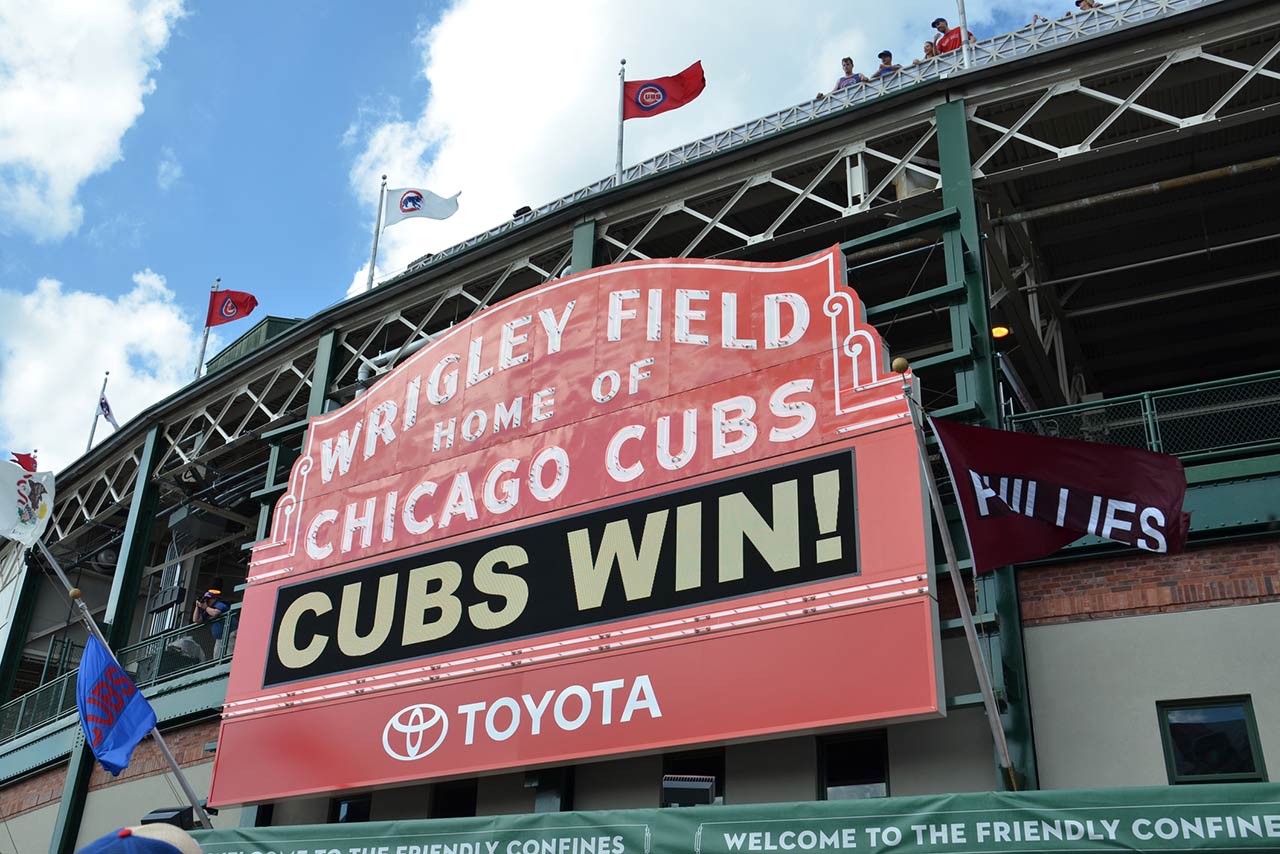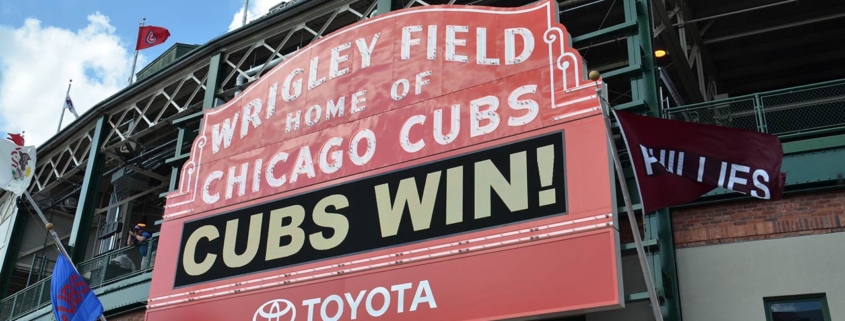Neighborhood News: Here’s to Opening Day at Lakeview’s Wrigley Field!

“I believe in the Church of Baseball. I’ve tried all the major religions and most of the minor ones…. And the only church that truly feeds the soul, day-in day-out, is the Church of Baseball.”
Annie Savoy (Susan Sarandon), Bull Durham
As the Chicago Cubs take on the Milwaukee Brewers at 1:20pm today to open the 2023 Major League Baseball season, let’s take a moment to remember what an iconic place the ‘Friendly Confines,’ has been for 107 seasons at what is now known as Wrigley Field, 1060 West Addison Street. For starters, it’s the second-oldest ballpark in the United States. The only ballpark older than Wrigley is Boston’s Fenway Park (1912).
Things you may not know…
The Cubs, an active franchise since 1870, moved to Weeghman Park (later Wrigley) from West Side Park, which was located at Taylor, Wood, Polk and Lincoln (now Wolcott) Streets. From 1906 through 1910, the Cubs won four National League pennants and two World Series championships at West Side Park. The 1906 World Series between the Cubs and the Chicago White Sox featured the first cross-town matchup in Series history.
Wrigley Field opened in 1914 as Weeghman Park for Charles Weeghman’s Chicago Whales of the Federal League, which folded after the 1915 baseball season, according to Wikipedia sources. Designed by Weeghman’s friend, architect Zachary Taylor Davis, the cost of building Weeghman Park, with a seating capacity of 14,000, was estimated at $250,000. After the Whales folded, Weeghman purchased the Cubs from the Taft family of Cincinnati and moved the club to the ballpark at the corner of Clark and Addison streets.
Play Ball… base and foot!
The Cubs played their first home game on April 20, 1916, defeating the Cincinnati Reds 7–6 in 11 innings. According to the Cubs’ website, the ballpark became known as Cubs Park in 1920 after chewing gum magnate William Wrigley Jr. (Doublemint, Juicy Fruit, etc.) of the Wrigley Company acquired the Cubs in 1921 It was named Wrigley Field in 1926 in honor of William Wrigley Jr., the club’s owner. Also, between 1921 and 1970, it was the home of football’s Chicago Bears and Chicago Cardinals (now the Arizona Cardinals) from 1931 to 1938.
And they were a pretty good team, winning National League championships in 1918, 1929, 1932, 1935, and 1938.
The Walls of Ivy…and the Birth of the ‘Bleacher Bums’
In 1937, the stadium was renovated. According to the Cubs’ website, the Wrigley Field bleachers and scoreboard were constructed in 1937 when the outfield area was renovated to provide improved and expanded seating. P. K. Wrigley discussed beautification with then-Cubs President William Veeck Sr., who suggested planting ivy on the outfield walls. His son, Bill, who later owned the White Sox, planted English ivy, but was later changed to Boston Ivy or Japanese Bittersweet, which can endure the harsh Chicago winters better. Veeck, Sr. was president of the Cubs from 1919 to his death in October, 1933. Under Veeck’s leadership, the Cubs won two pennants, in 1929 and 1932.
Following a change in MLB rules, which requires all outfield walls to be padded, Wrigley Field was grandfathered in, and is the only stadium in the league without padded walls. In 2004, according to Wikipedia sources, the ivy was specifically included in Wrigley Field’s Landmark Designation by the Chicago City Council in 2020. Under the ground rules of Wrigley Field, if a baseball gets gets stuck in the ivy, the batter is awarded a ground rule double.
According to the National Park Service website, the Cubs’ 27-foot high scoreboard was also added at this time, and remains manually operated to this day. One of the traditions of the ballpark is the flying of a flag bearing a “W” or an “L” atop the scoreboard after a game. A white flag with a blue “W” indicates a victory; a blue flag with a white “L” denotes a loss.
Finally: Three flags fly on the left field foul pole: Ernie Banks’ uniform No. 14, Ron Santo’s No. 10 and Fergie Jenkins’ No. 3. Four flags fly on the right field foul pole: Billy Williams’ No. 26, Ryne Sandberg’s No. 23, Greg Maddux’s No. 31 and Jackie Robinson’s No. 42. And there’s a “Hey, Hey!” for broadcaster Jack Brickhouse’s call after home runs. And don’t forget Harry Caray’s seventh inning stretch rendition of ‘Take Me Out to the Ballgame!’
And Finally… That Goat…
The ‘Curse of the Billy Goat,’ according to Wikipedia sources, was placed on the Cubs in 1945, by Billy Goat Tavern owner William Sianis. The curse lasted 71 years, from 1945 to 2016. During game 4 of the 1945 World Series at Wrigley Field against the Detroit Tigers, Sianis’s pet goat, named Murphy, was bothering other fans, and so the pair were asked to leave the stadium. Outraged, Sianis allegedly declared, “Them Cubs, they ain’t gonna win no more.”
Ironically, the “curse” was broken on the 46th anniversary of Billy Sianis’s death. The Cubs beat the Cleveland Indians in the 2016 World Series in seven games after trailing 3 games to 1. They won by a score of 8–7 in 10 innings at Progressive Field in Cleveland, Ohio, ending a 108-year championship drought.
What will happen in the 2023 campaign? Only time will tell.
GoCubsGo!!
Alison Moran-Powers and Dean’s Team Chicago

